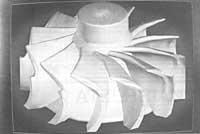CAD and CAM systems: evolution and integration
1994/02/01 Enparantza, Rafa Iturria: Elhuyar aldizkaria
CAD (Computer Aided Design) and CAM (Computer Aided Manufacturing) systems are already known in the broad field of engineering.
As is known, the CAD system allows to create on computer screen the design of any type of product. The first CAD systems were only for two-dimensional graphical representations, that is, to visualize the normalized views that were used until then to represent the shapes, dimensions and characteristics of the products represented in the paper planes. In a short time, drawing techniques and skills that were used for many years had to be abandoned in part. The ease it offers to direct and even to transport, made it essential to recycle the personnel of the technical offices.
In Euskal Herria we also knew this transformation, especially since the eighties. And it has not been much slower than in neighboring countries, at least in the companies that have managed to stay. It is difficult to find companies that do not currently have the CAD system, although traditional technical drawing has not yet been totally discarded.
The next step was three-dimensional CAD systems, which can present the product in its true spatial form, with a desired view.

Stereolithography and "virtual reality" are the latest results of CAD. The first one turns the “electronic” product generated in the computer into a physical model; the second, without creating a physical model, allows to manipulate the image of the product that is in the computer itself.
CAM systems operate in a narrower frame of chip removal manufacturing.
Its function is to determine the path that the tool must follow to obtain a mechanical part. Although in most mechanical parts the tool travel is a two-dimensional problem, its automatic determination is not as simple as canvases. They are now able to automatically obtain the tool paths needed to machine complex surfaces that 5-axis machines can generate.
Obviously, the benefit of integration between CAD and CAM systems. In fact, the CAM system contains part geometry and input information can be offered by the CAD without the need for redesign. Time savings and working comfort also significantly improve on integrated CAD-CAM systems.
The key to the integration is that the CAM system can retrieve and interpret directly the information contained in the files created by the CAD. To do this, an interface program for reading these files must be added to the CAM system.
And there the problems arise, because each CAD system, and many are in the market, because the files it generates have a special structure. That is, a CAM system from another software company would not be able to read these files. This means that you have to purchase the full CAD-CAM package to each software.
Logically, the integration problem occurs not only between CAD and CAM systems, but also between CAD packages. That is, two companies using different CAD systems are not able to exchange electronic product information. As usual, they have to go to paper. The solution to this problem is standardization. But that's a topic for a next article.

Gai honi buruzko eduki gehiago
Elhuyarrek garatutako teknologia




